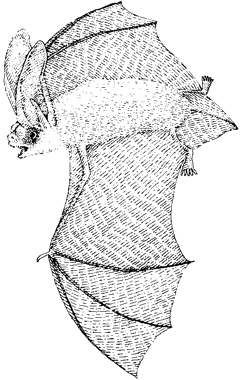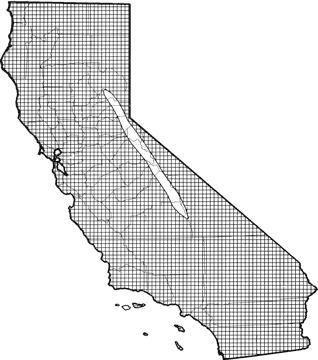
Townsend's Big-eared Bat
Distribution, Abundance, and Seasonality
Townsend's big-eared bat is found throughout California, but the details of its distribution are not well known. This species is found in all but subalpine and alpine habitats, and may be found at any season throughout its range. Once considered common, Townsend's big-eared bat now is considered uncommon in California. It is most abundant in mesic habitats.

Range Map
Specific Habitat Requirements
Feeding: Small moths are the principal food of this species. Beetles and a variety of soft-bodied insects also are taken. Captures their prey in flight using echolocation, or by gleaning from foliage. Flight is slow and maneuverable. Capable of hovering.
Cover: Requires caves, mines, tunnels, buildings, or other human-made structures for roosting. May use separate sites for night, day, hibernation, or maternity roosts. Hibernation sites are cold, but not below freezing. Individuals may move within the hibernaculum to find suitable temperatures. Maternity roosts are warm. Roosting sites are the most important limiting resource.
Reproduction: Maternity roosts are found in caves, tunnels, mines, and buildings. Small clusters or groups (usualIy fewer than 100 individuals) of females and young form the maternity colony. Maternity roosts are in relatively warm sites.
Water: Drinks water. Relatively poor urine-concentrating ability in comparison to other southwestern bats.
Pattern: Prefers mesic habitats. Gleans from brush or trees or feeds along habitat edges.
Species Life History
Activity Patterns: Nocturnal. Hibernates. Peak activity is late in the evening preceded by flights close to the roost. Bats at hibernacula from October to April.
Seasonal Movements / Migration: This relatively sedentary species makes short movements to hibernation sites. Of 1500 banded bats, the longest movement was 32.2 km (20 mi) (Pearson et al. 1952).
Home Range: Colonies usually are at least 16-19 km (10-12 mi) apart. A density of 1 bat/126 ha (1/310 ac) was reported on Santa Cruz Island (Pearson et al. 1952). This species shows high site fidelity if undisturbed.
Territory: Not territorial. Males are solitary in spring and summer. Females form maternity colonies. Hibernates singly or in small clusters, usually several dozen or fewer.
Reproduction: Most mating occurs from November-February, but many females are inseminated before hibernation begins. Sperm is stored until ovulation occurs in spring. Gestation lasts 56-100 days, depending on temperature, size of the hibernating cluster, and time in hibernation. Births occur in May and June, peaking in late May. A single litter of 1 is produced annually. Young are weaned in 6 wk and fly in 2.5-3 wk after birth. Growth rate depends on temperature. The maternity group begins to break up in August. Females mate in their first autumn, males in their first or second autumn. About half of young females return to their birth site after their first hibernation. Subsequent return rates are 70-80%. Maximum recorded age is 16 yr.
Niche: Forages with many other species. Relatively specialized on moths, and slow, maneuverable flier. Gleans, and captures prey in the air by echolocation. Roosting sites may be shared with other species. Rabies is found in this species, but incidence is usually less than 1%.
Comments: This species is extremely sensitive to disturbance of roosting sites. A single visit may result in abandonment of the roost. All known nursery colonies in limestone caves in California apparently have been abandoned. Numbers reportedly have declined steeply in California. Especially sensitive to injury by wing banding (Humphrey and Kunz 1976). A California Species of Special Concern (Williams 1986).
Sources & References
California Department of Fish and Game, 1999.
California's Wildlife, Sacramento, CA.
Written by: J. Harris, reviewed by: P. Brown, edited by: D. Alley, R. Duke
Barbour, R. W., and W. H. Davis. 1969. Bats of America. Univ. of Kentucky Press, Lexington. 286pp. Cockrum. E. L., and S. P. Cross. 1964. Time of bat activity over waterholes. J. Mammal. 45:635-636. Dalquest, W. W. 1947. Notes on the natural history of the bat Corynorhinus rafinesquii in California. J. Mammal. 28:17-30. Farney, J., and E. D. Fleharty, 1969. Aspect ratio, loading, wing spans and membrane area of bats. J. Mammal. 50:362-367. Graham, R. E. 1966. Observations on the roosting habits of the big-eared bat. Plecotus townsendii in California limestone caves. Cave Notes 8:17-22. Handley, C. O., Jr. 1959. A revision of American bats of the genera Euderma and Plecotus. Procs. U.S. Nat. Mus. 110:95-246. Humphrey, S. R., and T. H. Kunz. 1976. Ecology of a Pleistocene relict, the western big- eared bat (Plecotus townsendii), in the southern Great Plains. J. Mammal. 57:470-494. Kunz, T. H., and R. A. Martin. 1982. Plecotus townsendii. Mammal. Species No. 175. 6pp. Pearson, O. P., M. R. Koford, and A. K. Pearson. 1952. Reproduction of the lump-nosed bat (Corynorhinus rafinesquii) in California. J. Mammal. 33:273-320. Whitaker, J. O., Jr., C. Maser, and L. E. Keller. 1977. Food habits of bats of western Oregon. Northwest Sci. 51:46-55. Whitaker, J. O., Jr., C. Maser, and S. P. Cross. 1981. Food habits of eastern Oregon bats, based on stomach and scat analyses. Northwest Sci. 55:281-292. Williams, D. F. 1986. Mammalian species of special concern in California. Calif. Dept. Fish and Game, Sacramento. Admin. Rep. 86-1. 112pp.
California Animal Facts | California's Wildlife